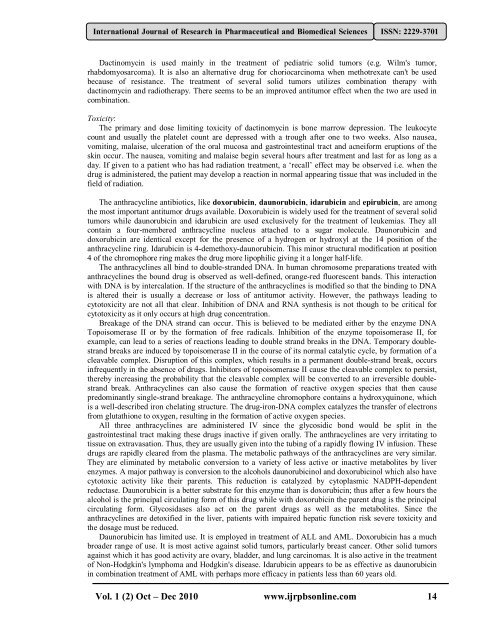Monitoring of Suspected Adverse Drug Reactions in Oncology Unit ...
Monitoring of Suspected Adverse Drug Reactions in Oncology Unit ...
Monitoring of Suspected Adverse Drug Reactions in Oncology Unit ...
Create successful ePaper yourself
Turn your PDF publications into a flip-book with our unique Google optimized e-Paper software.
International Journal <strong>of</strong> Research <strong>in</strong> Pharmaceutical and Biomedical Sciences ISSN: 2229-3701<br />
Dact<strong>in</strong>omyc<strong>in</strong> is used ma<strong>in</strong>ly <strong>in</strong> the treatment <strong>of</strong> pediatric solid tumors (e.g. Wilm's tumor,<br />
rhabdomyosarcoma). It is also an alternative drug for choriocarc<strong>in</strong>oma when methotrexate can't be used<br />
because <strong>of</strong> resistance. The treatment <strong>of</strong> several solid tumors utilizes comb<strong>in</strong>ation therapy with<br />
dact<strong>in</strong>omyc<strong>in</strong> and radiotherapy. There seems to be an improved antitumor effect when the two are used <strong>in</strong><br />
comb<strong>in</strong>ation.<br />
Toxicity:<br />
The primary and dose limit<strong>in</strong>g toxicity <strong>of</strong> dact<strong>in</strong>omyc<strong>in</strong> is bone marrow depression. The leukocyte<br />
count and usually the platelet count are depressed with a trough after one to two weeks. Also nausea,<br />
vomit<strong>in</strong>g, malaise, ulceration <strong>of</strong> the oral mucosa and gastro<strong>in</strong>test<strong>in</strong>al tract and acneiform eruptions <strong>of</strong> the<br />
sk<strong>in</strong> occur. The nausea, vomit<strong>in</strong>g and malaise beg<strong>in</strong> several hours after treatment and last for as long as a<br />
day. If given to a patient who has had radiation treatment, a ‘recall’ effect may be observed i.e. when the<br />
drug is adm<strong>in</strong>istered, the patient may develop a reaction <strong>in</strong> normal appear<strong>in</strong>g tissue that was <strong>in</strong>cluded <strong>in</strong> the<br />
field <strong>of</strong> radiation.<br />
The anthracycl<strong>in</strong>e antibiotics, like doxorubic<strong>in</strong>, daunorubic<strong>in</strong>, idarubic<strong>in</strong> and epirubic<strong>in</strong>, are among<br />
the most important antitumor drugs available. Doxorubic<strong>in</strong> is widely used for the treatment <strong>of</strong> several solid<br />
tumors while daunorubic<strong>in</strong> and idarubic<strong>in</strong> are used exclusively for the treatment <strong>of</strong> leukemias. They all<br />
conta<strong>in</strong> a four-membered anthracycl<strong>in</strong>e nucleus attached to a sugar molecule. Daunorubic<strong>in</strong> and<br />
doxorubic<strong>in</strong> are identical except for the presence <strong>of</strong> a hydrogen or hydroxyl at the 14 position <strong>of</strong> the<br />
anthracycl<strong>in</strong>e r<strong>in</strong>g. Idarubic<strong>in</strong> is 4-demethoxy-daunorubic<strong>in</strong>. This m<strong>in</strong>or structural modification at position<br />
4 <strong>of</strong> the chromophore r<strong>in</strong>g makes the drug more lipophilic giv<strong>in</strong>g it a longer half-life.<br />
The anthracycl<strong>in</strong>es all b<strong>in</strong>d to double-stranded DNA. In human chromosome preparations treated with<br />
anthracycl<strong>in</strong>es the bound drug is observed as well-def<strong>in</strong>ed, orange-red fluorescent bands. This <strong>in</strong>teraction<br />
with DNA is by <strong>in</strong>tercalation. If the structure <strong>of</strong> the anthracycl<strong>in</strong>es is modified so that the b<strong>in</strong>d<strong>in</strong>g to DNA<br />
is altered their is usually a decrease or loss <strong>of</strong> antitumor activity. However, the pathways lead<strong>in</strong>g to<br />
cytotoxicity are not all that clear. Inhibition <strong>of</strong> DNA and RNA synthesis is not though to be critical for<br />
cytotoxicity as it only occurs at high drug concentration.<br />
Breakage <strong>of</strong> the DNA strand can occur. This is believed to be mediated either by the enzyme DNA<br />
Topoisomerase II or by the formation <strong>of</strong> free radicals. Inhibition <strong>of</strong> the enzyme topoisomerase II, for<br />
example, can lead to a series <strong>of</strong> reactions lead<strong>in</strong>g to double strand breaks <strong>in</strong> the DNA. Temporary doublestrand<br />
breaks are <strong>in</strong>duced by topoisomerase II <strong>in</strong> the course <strong>of</strong> its normal catalytic cycle, by formation <strong>of</strong> a<br />
cleavable complex. Disruption <strong>of</strong> this complex, which results <strong>in</strong> a permanent double-strand break, occurs<br />
<strong>in</strong>frequently <strong>in</strong> the absence <strong>of</strong> drugs. Inhibitors <strong>of</strong> topoisomerase II cause the cleavable complex to persist,<br />
thereby <strong>in</strong>creas<strong>in</strong>g the probability that the cleavable complex will be converted to an irreversible doublestrand<br />
break. Anthracycl<strong>in</strong>es can also cause the formation <strong>of</strong> reactive oxygen species that then cause<br />
predom<strong>in</strong>antly s<strong>in</strong>gle-strand breakage. The anthracycl<strong>in</strong>e chromophore conta<strong>in</strong>s a hydroxyqu<strong>in</strong>one, which<br />
is a well-described iron chelat<strong>in</strong>g structure. The drug-iron-DNA complex catalyzes the transfer <strong>of</strong> electrons<br />
from glutathione to oxygen, result<strong>in</strong>g <strong>in</strong> the formation <strong>of</strong> active oxygen species.<br />
All three anthracycl<strong>in</strong>es are adm<strong>in</strong>istered IV s<strong>in</strong>ce the glycosidic bond would be split <strong>in</strong> the<br />
gastro<strong>in</strong>test<strong>in</strong>al tract mak<strong>in</strong>g these drugs <strong>in</strong>active if given orally. The anthracycl<strong>in</strong>es are very irritat<strong>in</strong>g to<br />
tissue on extravasation. Thus, they are usually given <strong>in</strong>to the tub<strong>in</strong>g <strong>of</strong> a rapidly flow<strong>in</strong>g IV <strong>in</strong>fusion. These<br />
drugs are rapidly cleared from the plasma. The metabolic pathways <strong>of</strong> the anthracycl<strong>in</strong>es are very similar.<br />
They are elim<strong>in</strong>ated by metabolic conversion to a variety <strong>of</strong> less active or <strong>in</strong>active metabolites by liver<br />
enzymes. A major pathway is conversion to the alcohols daunorubic<strong>in</strong>ol and doxorubic<strong>in</strong>ol which also have<br />
cytotoxic activity like their parents. This reduction is catalyzed by cytoplasmic NADPH-dependent<br />
reductase. Daunorubic<strong>in</strong> is a better substrate for this enzyme than is doxorubic<strong>in</strong>; thus after a few hours the<br />
alcohol is the pr<strong>in</strong>cipal circulat<strong>in</strong>g form <strong>of</strong> this drug while with doxorubic<strong>in</strong> the parent drug is the pr<strong>in</strong>cipal<br />
circulat<strong>in</strong>g form. Glycosidases also act on the parent drugs as well as the metabolites. S<strong>in</strong>ce the<br />
anthracycl<strong>in</strong>es are detoxified <strong>in</strong> the liver, patients with impaired hepatic function risk severe toxicity and<br />
the dosage must be reduced.<br />
Daunorubic<strong>in</strong> has limited use. It is employed <strong>in</strong> treatment <strong>of</strong> ALL and AML. Doxorubic<strong>in</strong> has a much<br />
broader range <strong>of</strong> use. It is most active aga<strong>in</strong>st solid tumors, particularly breast cancer. Other solid tumors<br />
aga<strong>in</strong>st which it has good activity are ovary, bladder, and lung carc<strong>in</strong>omas. It is also active <strong>in</strong> the treatment<br />
<strong>of</strong> Non-Hodgk<strong>in</strong>'s lymphoma and Hodgk<strong>in</strong>'s disease. Idarubic<strong>in</strong> appears to be as effective as daunorubic<strong>in</strong><br />
<strong>in</strong> comb<strong>in</strong>ation treatment <strong>of</strong> AML with perhaps more efficacy <strong>in</strong> patients less than 60 years old.<br />
Vol. 1 (2) Oct – Dec 2010 www.ijrpbsonl<strong>in</strong>e.com 14

















